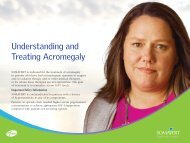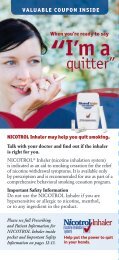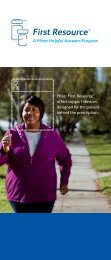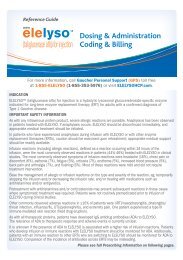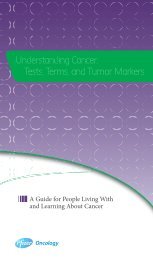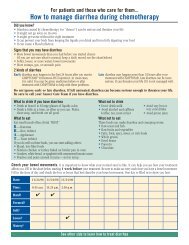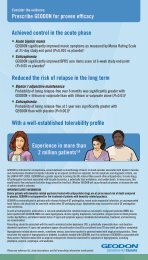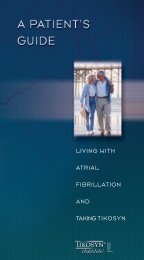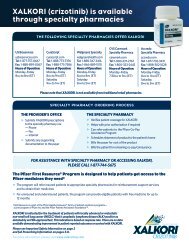Quick Inventory of Depressive Symptomatology (Clinician ... - PfizerPro
Quick Inventory of Depressive Symptomatology (Clinician ... - PfizerPro
Quick Inventory of Depressive Symptomatology (Clinician ... - PfizerPro
You also want an ePaper? Increase the reach of your titles
YUMPU automatically turns print PDFs into web optimized ePapers that Google loves.
<strong>Quick</strong> <strong>Inventory</strong> <strong>of</strong> <strong>Depressive</strong> <strong>Symptomatology</strong> (<strong>Clinician</strong>-Rated) (QIDS-C 16 )Patient Name:Date:Please circle the 1 response to each item that best describes the patient for the last 7 days.1. Sleep-onset insomnia0 Never takes longer than 30 minutes to fall asleep.1 Takes at least 30 minutes to fall asleep, less than half the time.2 Takes at least 30 minutes to fall asleep, more than half the time.3 Takes more than 60 minutes to fall asleep, more than half the time.5. Mood (sad)0 Does not feel sad.1 Feels sad less than half the time.2 Feels sad more than half the time.3 Feels intensely sad virtually all the time.2. Mid-nocturnal insomnia0 Does not wake up at night.1 Restless, light sleep with few awakenings.2 Wakes up at least once a night, but goes back to sleep easily.3 Awakens more than once a night and stays awakefor 20 minutes or more, more than half the time.6. Appetite (decreased)0 No change from usual appetite.1 Eats somewhat less <strong>of</strong>ten and/or lesser amounts than usual.2 Eats much less than usual and only with personal effort.3 Eats rarely within a 24-hour period, and only with extremepersonal effort or with persuasion by others.3. Early-morning insomnia0 Less than half the time, awakens no more than 30 minutesbefore necessary.1 More than half the time, awakens more than 30 minutesbefore need be.2 Awakens at least 1 hour before need be, more than half the time.3 Awakens at least 2 hours before need be, more than half the time.4. Hypersomnia0 Sleeps no longer than 7–8 hours/night, without naps.1 Sleeps no longer than 10 hours in a 24-hour period (including naps).2 Sleeps no longer than 12 hours in a 24-hour period (including naps).3 Sleeps longer than 12 hours in a 24-hour period (including naps).Enter the highest score on any 1 <strong>of</strong> the 4 sleep items(1–4 above):7. Appetite (increased)0 No change from usual appetite.1 More frequently feels a need to eat than usual.2 Regularly eats more <strong>of</strong>ten and/or greater amounts than usual.3 Feels driven to overeat at and between meals.8. Weight (decrease) within the last 2 weeks0 Has experienced no weight change.1 Feels as if some slight weight loss occurred.2 Has lost 2 pounds or more.3 Has lost 5 pounds or more.9. Weight (increase) within the last 2 weeks0 Has experienced no weight change.1 Feels as if some slight weight gain has occurred.2 Has gained 2 pounds or more.3 Has gained 5 pounds or more.Enter the highest score on any 1 <strong>of</strong> the 4 appetite/weightchange items (6–9 above):1
10. Concentration/decision making14. Energy/fatigability0 No change in usual capacity to concentrate and decide.0 No change in usual level <strong>of</strong> energy.1 Occasionally feels indecisive or notes that attention <strong>of</strong>ten wanders. 1 Tires more easily than usual.2 Most <strong>of</strong> the time struggles to focus attention or make decisions. 2 Makes significant personal effort to initiate or maintain3 Cannot concentrate well enough to read or cannot makeusual daily activities.even minor decisions.3 Unable to carry out most <strong>of</strong> usual daily activities due to lack<strong>of</strong> energy.11. Outlook (self)0 Sees self as equally worthwhile and deserving as others. 15. Psychomotor slowing1 Is more self-blaming than usual.0 Normal speed <strong>of</strong> thinking, gesturing, and speaking.2 Largely believes that he/she causes problems for others.1 Patient notes slowed thinking, and voice modulation is reduced.3 Ruminates over major and minor defects in self.2 Takes several seconds to respond to most questions; reportsslowed thinking.12. Suicidal ideation3 Is largely unresponsive to most questions without strong0 Does not think <strong>of</strong> suicide or death.encouragement.1 Feels life is empty or is not worth living.2 Thinks <strong>of</strong> suicide/death several times a week for several minutes. 16. Psychomotor agitation3 Thinks <strong>of</strong> suicide/death several times a day in depth,0 No increased speed or disorganization in thinking or gesturing.or has made specific plans for or attempted suicide.1 Fidgets, wrings hands and shifts positions <strong>of</strong>ten.2 Describes impulse to move about and displays motor13. Involvementrestlessness.0 No change from usual level <strong>of</strong> interest in other people and3 Unable to stay seated; paces about with or withoutactivities.permission.1 Notices a reduction in former interests/activities.2 Finds only 1 or 2 former interests remain.Enter the highest score on either <strong>of</strong> the 2 psychomotor items3 Has virtually no interest in formerly pursued activities.(15 or 16 above):Total Score: (Range 0–27)For more information on scoring and interpretation, see the correspondence tables available at the IDS-QIDS home page <strong>of</strong> the University <strong>of</strong> PittsburghEpidemiology Data Center (www.ids-qids.org).This tool should be used to supplement, not to replace, clinical judgment.Adapted from Rush AJ, Trivedi MH, Ibrahim HM, et al. The 16-item <strong>Quick</strong> <strong>Inventory</strong> <strong>of</strong> <strong>Depressive</strong> <strong>Symptomatology</strong> (QIDS), <strong>Clinician</strong> Rating (QIDS-C), and Self-Report(QIDS-SR): a psychometric evaluation in patients with chronic major depression. Biol Psychiatry. 2003;54:573-583.© 2007 The University <strong>of</strong> Texas Southwestern Medical Center at Dallas. The QIDS-C and QIDS-SR may be copied and used without permission if administered in apaper-and-pencil format or in an electronic format that does not change any <strong>of</strong> the item ordering, or wording, at all. Users wishing to adapt either QIDS to a telephonicformat, interactive voice response system, or other electronic format, including PDA, must contact The University <strong>of</strong> Texas Southwestern Medical Center at Dallas.2



